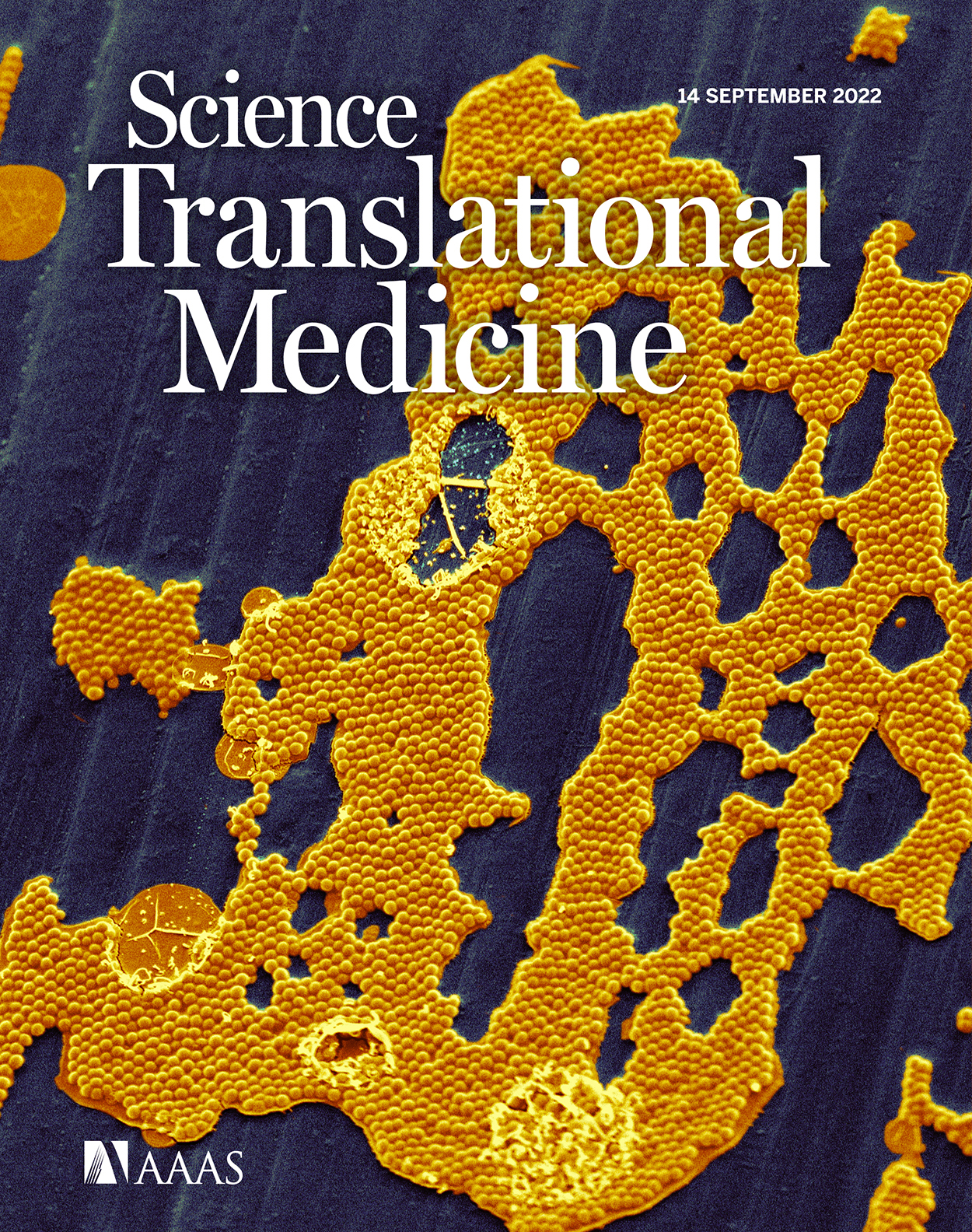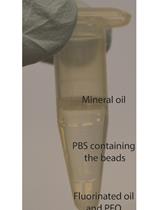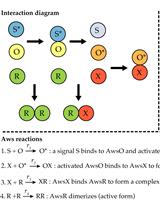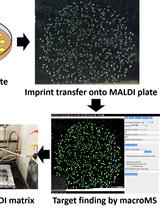- EN - English
- CN - 中文
Rapid Multiplexed Flow Cytometric Validation of CRISPRi sgRNAs in Tissue Culture
组织培养中CRISPRi sgRNAs的快速多通道流式细胞术验证
发布: 2023年01月20日第13卷第2期 DOI: 10.21769/BioProtoc.4591 浏览次数: 2459
评审: ASWAD KHADILKARAnonymous reviewer(s)
Abstract
Genome-wide CRISPR-based screening is a powerful tool in forward genetics, enabling biologic discovery by linking a desired phenotype to a specific genetic perturbation. However, hits from a genome-wide screen require individual validation to reproduce and accurately quantify their effects outside of a pooled experiment. Here, we describe a step-by-step protocol to rapidly assess the effects of individual sgRNAs from CRISPR interference (CRISPRi) and CRISPR activation (CRISPRa) systems. All steps, including cloning, lentivirus generation, cell transduction, and phenotypic readout, can be performed entirely in 96-well plates. The system is highly flexible in both cell type and selection system, requiring only that the phenotype(s) of interest be read out via flow cytometry. We expect that this protocol will provide researchers with a rapid way to sift through potential screening hits, and prioritize them for deeper analysis in more complex in vitro or even in vivo systems.
Graphical abstract

Background
Pooled screening methods leveraging the CRISPR/Cas9 (Clustered Regularly Interspaced Palindromic Repeats) system constitute powerful tools for unbiased profiling of gene function across the coding genome (Shalem et al., 2015; Bock et al., 2022). CRISPR interference (CRISPRi) uses a nuclease-dead Cas9 (dCas9) fused to a transcriptional repressor to produce highly potent gene silencing (Qi et al., 2013; Gilbert et al., 2014), with the advantages of avoiding toxicity from double-strand DNA breaks, increased specificity for genetic targets, potential reversibility of effects, and multiplexed gene knockdown (Horlbeck et al., 2016; Mandegar et al., 2016; Reis et al., 2019). A successful genome-wide screening experiment is expected to yield a list of potential genetic hits whose perturbations affect the phenotype of interest. Yet, these hits require subsequent validation for several reasons. First, the effects of individual gene knockdowns need to be confirmed in isolated, as opposed to pooled, conditions. Second, independent confirmation of multiple small-guide RNA (sgRNA) sequences against the same target gene increases the confidence that the desired phenotype results from on-target knockdown. Third, identifying the most potent sgRNA facilitates downstream interrogation of gene function. Fourth, sequence-specific toxicity unique to a particular sgRNA must be excluded (Cui et al., 2018). Lastly, in the pooled screen, the strength of the genetic perturbation effect is only indirectly inferred from the degree of sgRNA enrichment among cells displaying a pre-defined phenotypic strength. Therefore, a direct assessment of effect strength requires a quantitative evaluation of the individual gene knockdown on the phenotype of interest, as well as a comparison to a non-targeting control.
Unbiased screens may produce a hit list of hundreds of genes, requiring cloning, lentiviral generation, transduction, and phenotypic analysis of at least twice the number of sgRNAs. Interrogating this list can be time-consuming and costly, if using traditional cloning or viral generation methods. To address this bottleneck, here we describe a step-by-step protocol to generate and phenotype individual sgRNA expressing cells entirely in 96-well plates, which we have used to identify a previously undiscovered regulator of the low density lipoprotein receptor (LDLR) (Smith et al., 2022). The protocol is applicable to either the CRISPRi or CRISPR activation (CRISPRa) systems, as both use the same sgRNA delivery vector (Horlbeck et al., 2016), and offers flexibility in phenotypic analysis. The flow cytometry readout offers functional insights at the single cell level. Comparisons can be performed either against non-transduced cells in the same microenvironment, or between separately generated cell populations harboring either a targeting or control sgRNA after puromycin selection. We limit our described protocols to the measurements of cell surface markers detectable by fluorophore antibody conjugates, and the internalization of fluorescently labeled ligands. However, in principle, the protocol could be amended to use any fluorescence-based readout compatible with flow cytometry on the cell type of interest. Furthermore, as this is fundamentally a method to deliver and phenotype many clonally derived vectors in parallel, we expect that it would be easily adaptable to other moderate-sized focused lentiviral libraries.
Materials and Reagents
0.2 mL PCR tubes (USA Scientific, catalog number: 1402-2900)
Sterilized, low retention, LTS pipette tips (Rainin, catalog numbers: 30389213, 30389240, 30389226)
1.5 mL Eppendorf Safe-Lock centrifuge tubes (USA Scientific, catalog number: 4036-3204)
Falcon 15 mL conical centrifuge tubes (Corning catalog number: 352097)
Falcon 50 mL conical centrifuge tubes (Corning, catalog number: 352098)
Accutec razor blades (ThermoFisher Scientific, catalog number: S17302)
14 mL culture tubes (Avantor/VWR, catalog number: 60818-689)
Parafilm (ThermoFisher Scientific, catalog number: S37440)
96-well, cell culture-treated, flat-bottom microplate (Corning, catalog number: 3903)
5 mL, 10 mL, 25 mL, and 50 mL serologic pipettes (Santa Cruz Biotechnology, catalog numbers: sc-200279, sc-200281, sc-200283, sc-213234)
Countess cell counting chamber slides (ThermoFisher Scientific, catalog number: C10228)
Sterile 96-well v-bottom polypropylene plates (Corning, catalog number: 3357)
50 mL, 250 mL, 500 mL, and 1000 mL Nalgene Rapid-Flow sterile single use vacuum filter units (ThermoFisher Scientific, catalog numbers: 5640020, 5680020, 5660020, 5670020)
23G sterile blunt needles (ThermoFisher Scientific, catalog number: NC9031029)
NORM-JECT luer lock sterile syringes (Avantor/VWR, catalog number: 53548-023)
90 micron nylon mesh (Elko Filtering, catalog number: 03-90/49)
Polypropylene microtiter (“bullet”) tubes (ThermoFisher Scientific, catalog number: 02-681-376)
5 mL round bottom polystyrene with cell strainer cap (Corning, catalog number: 352235)
MultiScreenHTS HV sterile filter plate, 0.45 µm (Millipore Sigma, catalog number: MSHVS4510)
Aluminum foil (Avantor/VWR, catalog number: 89125-940)
Desalted, custom synthesized oligonucleotides (see step A1)
pCRISPRi/a v2 [Addgene, catalog number: 84832, and described in Horlbeck et al. (2016), store at -20°C]
FastDigest BstXI (ThermoFisher Scientific, catalog number: FD1024, store at -20°C)
FastDigest Bpu1102I/BlpI (ThermoFisher Scientific, catalog number: FD0094, store at -20°C)
Agarose LE (Goldbio, catalog number: A-201-100)
SYBR Safe DNA gel stain (ThermoFisher Scientific, catalog number: S33102)
E.Z.N.A. gel extraction kit (Omega Bio-Tek, catalog number: D2500-02)
E.Z.N.A. plasmid DNA mini kit I (Omega Bio-Tek, catalog number: D6942-02, some components of kit require storage at 4°C)
Isopropanol (Millipore Sigma, catalog number: 59304)
1 kb DNA ladder (Goldbio, catalog number: D010-500, store long-term at -20°C, short-term at R.T.)
KOPTEC absolute ethanol (Avantor/VWR, catalog number: 89125-172)
Sodium acetate (Millipore Sigma, catalog number: S2889)
TempPlate non-skirted 96-well PCR plate, 0.2 mL (USA Scientific, catalog number: 1402-9596)
Adhesive PCR plate foil seals (Avantor/VWR, catalog number: 60941-076)
Potassium acetate (Millipore Sigma, catalog number: P1190)
HEPES (Goldbio, catalog number: H-400-100)
Tris base (Goldbio, catalog number: T-400-500)
Concentrated hydrochloric acid (Avantor/VWR, catalog number: JT9535)
Potassium hydroxide (Millipore Sigma, catalog number: P5958)
Magnesium acetate (Millipore Sigma, catalog number: M5661)
T4 DNA Ligase (New England BioLabs, catalog number: M0202L, store both enzyme and buffer at -20°C)
One Shot Mach1 T1 phage-resistant chemical competent E. coli (ThermoFisher Scientific, catalog number: C862003, store at -80°C)
Mix & Go! E. coli transformation kit (Zymo Research, catalog number: T3001, some components of kit require storage at 4°C)
LB Broth (Millipore Sigma, catalog number: L3522)
Carbenicillin (Goldbio, catalog number: C-103-5, store at -20°C)
LB-agar plates carbenicillin-100 (Teknova, catalog number: L1010, store at 4°C)
Zyppy-96 plasmid kit (Zymo Research, catalog number: D4042, some components of kit require storage at 4°C)
Lab markers (ThermoFisher Scientific, catalog number: 13-379-4)
Glycerol (Millipore Sigma, catalog number: G2025)
HEK-293T cells (ATCC, catalog number: CRL-3126, store at -80 to -150°C)
Gibco high-glucose DMEM with pyruvate and GlutaMax supplement (ThermoFisher Scientific, catalog number: 10569010, store at 4°C protected from light)
Gibco low-glucose DMEM with pyruvate and GlutaMax supplement (ThermoFisher Scientific, catalog number: 10567014, store at 4°C protected from light)
Heat-inactivated fetal bovine serum (FBS) (Axenia Biologix, catalog number: F002, aliquot and store at -20°C)
Lipoprotein depleted FBS (Kalen Biomedical, catalog number: 880100, aliquot and store at -20°C)
Human 3,3’-dioctadcylindocarbocyanine low density lipoprotein (DiI-LDL) (Kalen Biomedical, catalog number: 770230-9, store at 4°C protected from light)
Clorox bleach (Office Depot, catalog number: 217595)
Lentiviral packaging vectors: pCMV-dR8.91 and pMD2.G (Addgene, catalog number: 12259, and described in (Gilbert et al., 2014), store at -20°C)
ViralBoost reagent (Alstem, catalog number: VB100, store at 4°C)
Opti-MEM I reduced serum medium (ThermoFisher Scientific, catalog number: 31985062, store at 4°C protected from light)
TransIT-LT1 transfection reagent (Mirus Bio, catalog number: MIR2300, store at 4°C)
Puromycin (Invivogen, catalog number: ant-pr-1, store at -20°C)
Bovine serum albumin (Millipore Sigma, catalog number: 12659, store at 4°C)
Sterile reagent reservoirs (Corning, catalog number: 4870)
Polybrene infection/transfection reagent (ThermoFisher Scientific, catalog number: TR-1003-G, store at -20°C))
Trypsin-EDTA (0.25%) with phenol red (ThermoFisher Scientific, catalog number: 25-200-114, store long-term at -20°C, short-term at 4°C)
Phosphate buffered saline (PBS), pH 7.4, sterile (ThermoFisher Scientific, catalog number: 10010049)
Accutase (Innovative Cell Technologies, catalog number: AT104, store long-term at -20°C, short-term at 4°C)
Gibco 100× penicillin-streptomycin (ThermoFisher Scientific, catalog number: 15140122, store long-term at -20°C, short-term at 4°C)
DNase I (Goldbio, catalog number: D-300-100, store at -20°C)
CRISPRi-ready cells (dCas9-BFP-KRAB HepG2 cells are described in (Smith et al., 2022), store at -80 to -150°C)
Ghost Dye red 780 (Tonbo Biosciences, catalog number: 13-0865-T100, store at -20°C)
Human LDLR Alexa Fluor 647-conjugated antibody (R&D Systems, catalog number: FAB2148R, store at 4°C)
Human TfR Alexa Fluor 488-conjugated antibody (R&D Systems, catalog number: FAB2474G, store at 4°C)
Dimethyl sulfoxide (Millipore Sigma, catalog number: D2650)
16% formaldehyde solution (Avantor/VWR, catalog number: 100503-917)
2× Annealing Buffer (see Recipes)
50× TAE Buffer (see Recipes)
293T growth medium (see Recipes)
Viral harvest medium (see Recipes)
HepG2 growth medium (see Recipes)
Sterol-depleted medium (see Recipes)
FACS buffer (FB) (see Recipes)
DiI-LDL labeling medium (see Recipes)
Equipment
2 µL, 20 µL, 200 µL, and 1000 µL LTS Pipet-Lite XLS+ manual single channel pipettes (Rainin, catalog number: 30386597)
10 µL, 20 µL, and 200 µL Pipet-Lite XLS+ manual 12-channel pipettes (Rainin, catalog numbers: 17013807, 17013808, 17013810)
Pipet-Aid XP2 (USA Scientific, catalog number: 4440-5010)
Milli-Q Direct 16 water purification system (Millipore Sigma, catalog number: ZR0Q016WW)
ProFlex 3 × 32 well PCR thermocycler (ThermoFisher Scientific, catalog number: 4484073)
Mini-Sub Cell GT horizontal electrophoresis system and PowerPac basic power supply (Bio-Rad, catalog number: 1640300)
E-Gel imager system with blue-light base (ThermoFisher Scientific, catalog number: 4466612)
Dry block heater with 1.5 mL microcentrifuge tube block (Avantor/VWR, catalog numbers: 75838-318, 13259-286)
QIAVac 24 Plus vacuum manifold (Qiagen, catalog number: 19413)
Microcentrifuge (Eppendorf, catalog number: 5425)
NanoDrop 2000 UV-Vis spectrophotometer (ThermoFisher Scientific, catalog number: ND-2000)
Heratherm compact microbiological incubator (ThermoFisher Scientific, catalog number: 50125590)
New Brunswick Innova 44R incubator shaker (Eppendorf, catalog number: M12820006)
Binder CO2 incubator (Avantor/VWR, catalog number: CB170)
Vortex mixer (Avantor/VWR, catalog number: 10153-838)
FiveEasy pH meter (Mettler Toledo, catalog number: 30266626)
-20°C laboratory freezer (ThermoFisher Scientific, catalog number: 02LFEETSA)
Ice buckets (Avantor/VWR, catalog number: 10146-188)
Allegra X-30R benchtop centrifuge with SX4400 and S606 rotors (Beckman Coulter, catalog number: B06320)
Scotsman FLAKER ice maker (CurranTaylor, catalog number: SCF1415A)
Aluminum alloy cooling block for 0.2 mL PCR tubes (ThermoFisher Scientific, catalog number: 13-131-013)
Laboratory refrigerator (ThermoFisher Scientific, catalog number: TSG25RPGA)
Ultra low temperature freezer (ThermoFisher Scientific, Forma catalog number: 995)
Countess II FL automated cell counter (ThermoFisher Scientific, catalog number: A32136)
Flow cytometer, such as: LSRFortessa with HTS sampler (BD Biosciences), LSRII (BD Biosciences), or CytoFLEX (Beckman Coulter)
Autoclave machine
Tissue culture hood
Laboratory microscope (for tissue culture)
Chemical fume hood
Software
ApE, A plasmid Editor [Described in Davis and Jorgensen (2022) https://jorgensen.biology.utah.edu/wayned/ape/]
Flow cytometer acquisition software: FACSDiva (BD Biosciences, https://www.bdbiosciences.com/en-us/products/software/instrument-software/bd-facsdiva-software) or CytExpert (Beckman Coulter, https://www.beckman.com/flow-cytometry/research-flow-cytometers/cytoflex/software)
Prism (GraphPad, https://www.graphpad.com)
FlowJo (BD Biosciences, https://www.flowjo.com)
Excel (Microsoft, https://www.microsoft.com/en-us/microsoft-365/excel)
Procedure
文章信息
版权信息
© 2023 The Authors; exclusive licensee Bio-protocol LLC.
如何引用
Readers should cite both the Bio-protocol article and the original research article where this protocol was used:
- Chorba, J. S., Xia, V. Q., Smith, G. A. and Padmanabhan, A. (2023). Rapid Multiplexed Flow Cytometric Validation of CRISPRi sgRNAs in Tissue Culture. Bio-protocol 13(2): e4591. DOI: 10.21769/BioProtoc.4591.
- Smith, G. A., Padmanabhan, A., Lau, B. H., Pampana, A., Li, L., Lee, C. Y., Pelonero, A., Nishino, T., et al. (2022). Cold shock domain-containing protein E1 is a posttranscriptional regulator of the LDL receptor. Sci Transl Med 14(662): eabj8670.
分类
系统生物学 > 基因组学 > 筛选
医学 > 心血管疾病
您对这篇实验方法有问题吗?
在此处发布您的问题,我们将邀请本文作者来回答。同时,我们会将您的问题发布到Bio-protocol Exchange,以便寻求社区成员的帮助。
Share
Bluesky
X
Copy link












